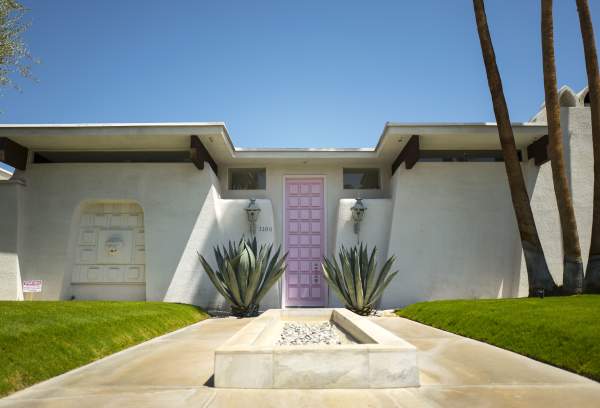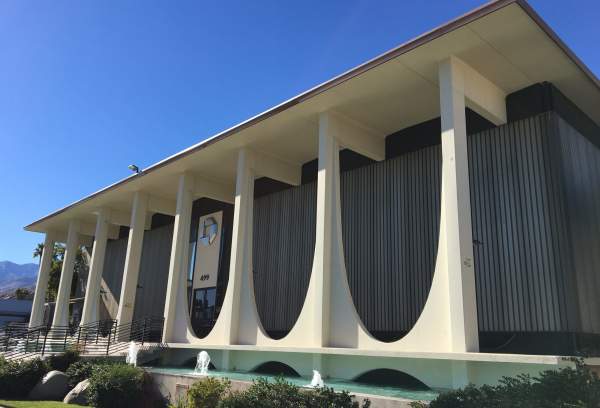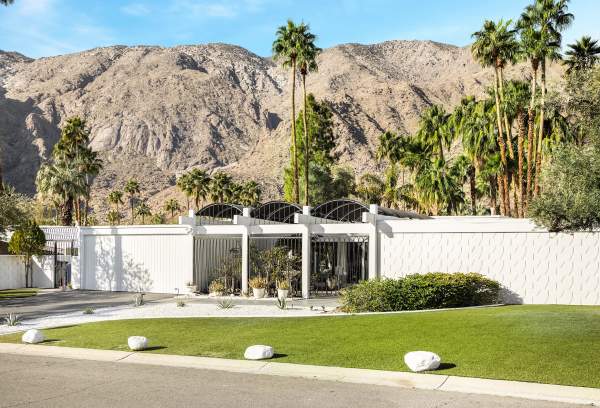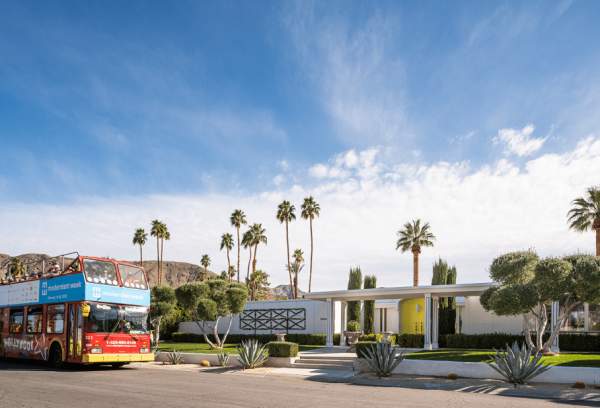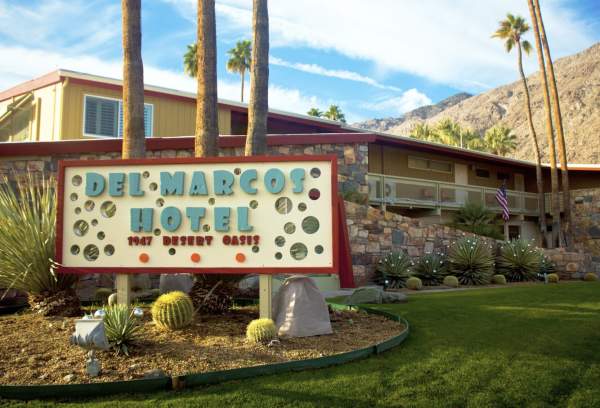Discover the people who helped shape the look of Palm Springs architecture.
George Alexander, Developer
George Alexander started as an accountant and became involved in real estate, leading him to become a developer in Los Angeles. George began investing in Palm Springs in 1930 as one of the original developers of the Smoke Tree Guest Ranch, among others. The Alexanders were also active in Palm Springs society, civically engaged, and known for their philanthropic work.
The idea of building modern homes, and lots of them, came from his son, Robert (Bob), but George thought the idea could have been better. George's vision for his construction company changed in 1956 when his health took a turn for the worse, and, under his doctor's advice to seek a warmer, drier climate, he decided to relocate his George Alexander Company base of operations to Palm Springs. The Alexanders had already been enamored of the desert, where they spent many weekends each winter. The timing couldn't have been better for the firm, as the popularity of the desert resort was ready to explode. It would be there where he and his sons Bob and Bill Krisel would form the desert team that would go down in Palm Springs Modernism history.
Bob asked architect William Krisel to make sketches and drawings until Alexander saw what he wanted to build. George, the firm's financier, selected and purchased sites throughout the Coachella Valley, and Bob Alexander did the building. Together, they would build over 1,200 homes in Palm Springs.
Ocotillo Lodge - 1957 - 1958
Twin Palms Estates - 1957 - 1958
Ramon Rise - 1956
Enchanted Homes - 1957
Racquet Club Road Estates - 1958 - 1960
Vista Las Palmas - 1956 - 1959
Golden Vista Estates - 1960
Racquet Club Estates - 1959 - 1960
Golf Club Estates - 1961
Steel Houses - 1961 - 1962
Riviera Gardens - 1961
Alexander Home – 1962 - 1350
Ladera Circle Las Palmas Summit - 1962
Desert Lanai - 1963
Farrell Canyon Estates - 1963
Araby Estates - 1964
Sunrise Estates - 1964
Green Fairway Estates - 1964 - 1965
John Porter Clark, Architect
In 1932, he established the firm’s office in Palm Springs and designed several buildings in the desert for them. Clark met Albert Frey when he came to Palm Springs to design the Kocher-Samson building and collaborated with him on several projects. In 1939, Clark and Frey formed a partnership. Clark left the firm in 1958 to establish his solo practice. Notable works include the Hamrick House (1941), Welwood Memorial Library (1940)
William F. Cody, Architect
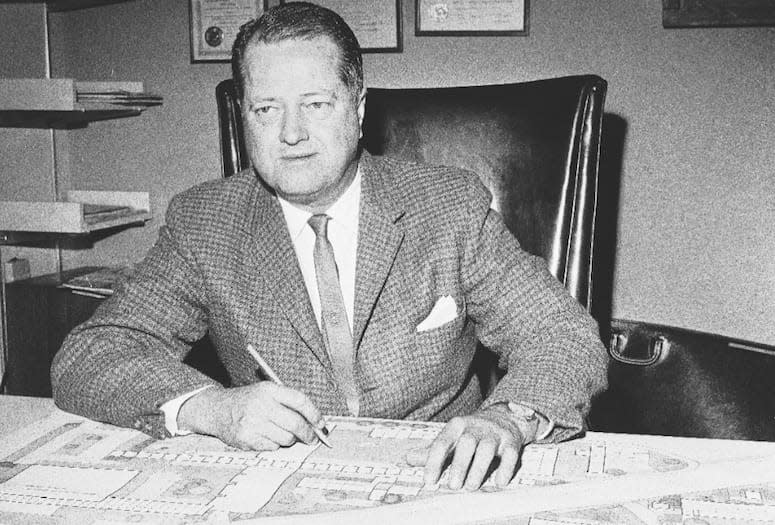
In 1945, Cody was retained to alter the Desert Inn, his first commission in Palm Springs. In 1947, he completed the Del Marcos Hotel, his first independent commission, which the AIA Southern California Chapter recognized with an honorable mention.
Post-World War II, Palm Springs was becoming a fashionable weekend and winter retreat for the rich and famous, and Cody’s career flourished along with the city. He moved his practice and his family to Palm Springs. In 1950, he was retained to lead the successful conversion of the Thunderbird Dude Ranch into the Thunderbird Country Club, which led to commissions to design or alter clubhouses, recreational facilities, and residential developments at Eldorado Country Club (with Ernest J. Kump), Tamarisk Country Club, the Racquet Club, and the Tennis Club. In 1960, he began almost a decade of work altering and expanding the Palm Springs Spa Hotel.
Cody’s specialization in country club clubhouses with related residential developments led to additional commissions in California, Arizona, Texas, Cuba, and Mexico. His residential projects emphasized key elements of Modernism: simplicity of form, natural light, and large windows offering a seamless connection between residential interiors and the outdoors. Because any one style does not box him in, it makes his style hard to pin down and often overlooked in architectural circles.
In 1945, Cody was retained to alter the Desert Inn in Palm Springs. By 1946, Cody was licensed to practice architecture in California and Arizona. After the Abernathy House, he went on to design the Palm Springs Library in 1972 but suffered a debilitating stroke midway through the project. He died in 1978 at the age of 62.
William Cody Residence, 1946, 1950 E. Desert Palms Drive
Del Marcos Hotel – 1947, 225 W Baristo Rd
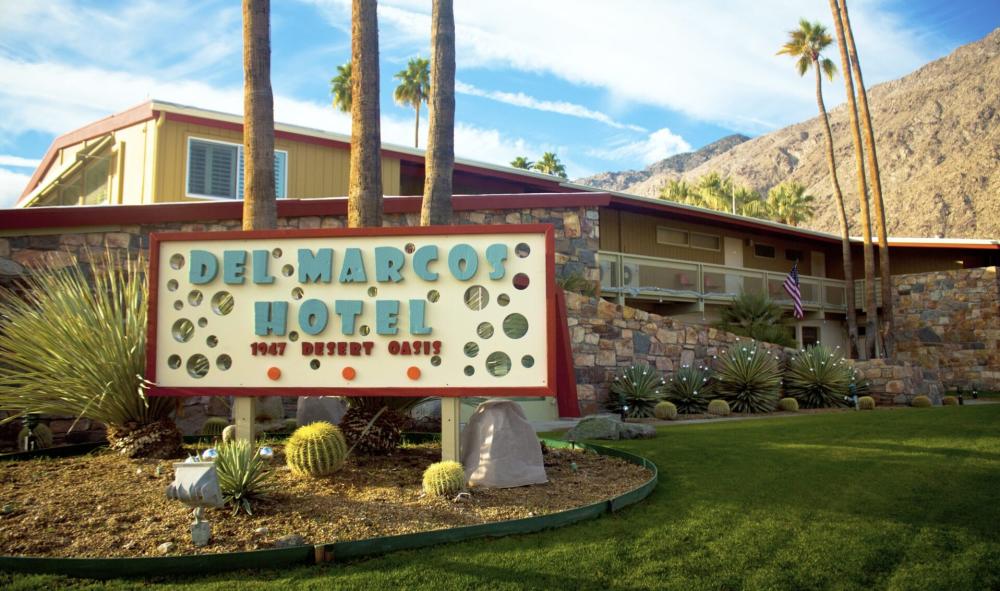
Levin Residence, 1948, 1940 E McManus Drive
Desert Palm Estates - 1951
L’Horizon Hotel – 1952, 1050 E Palm Canyon
The William Perlberg and Bobbie Brox House – 1952, 888 N. Avenida Palmas
Racquet Club Cottages West (RCCW) – 1960, 360 W. Cabrillo Road
Abernathy Residence – 1962, 611 North Phillips Road
Commercial Gas Station – 1964, 2796 N. Palm Canyon Drive
St Theresa Catholic Church – 1968, 2900 Ramon Rd
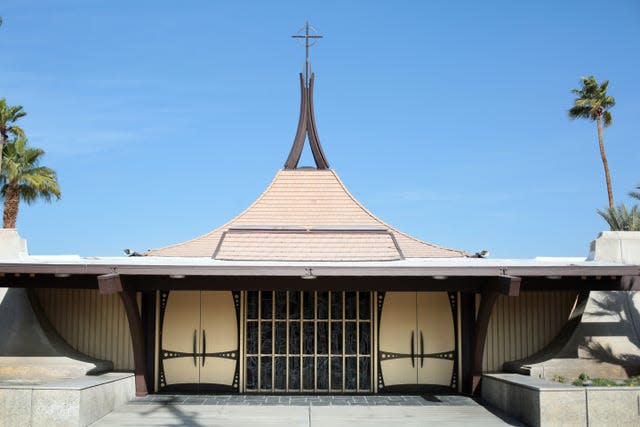
Glass House – 1967, 755 Cam Norte Palm Springs Library – 1975, 300 S Sunrise Way
Charles E. DuBois
Charles attended UCLA for a year and then transferred to MIT from 1922 to 1930. Traveling between coasts and working at different architectural firms throughout the 1920s, Charles Du Bois was a draftsman at Walker & Eisen (1923- 1931), at Gogerty & Weyl (1926-1929), and at Horatio W. Bishop (1929). Charles E. Du Bois passed the California and national exams in the 1930s and started his firm in 1938. During WWII, when housing construction slowed, he worked as a Senior Set Designer for MGM.
The Swiss Miss Houses - 1958 - 1962
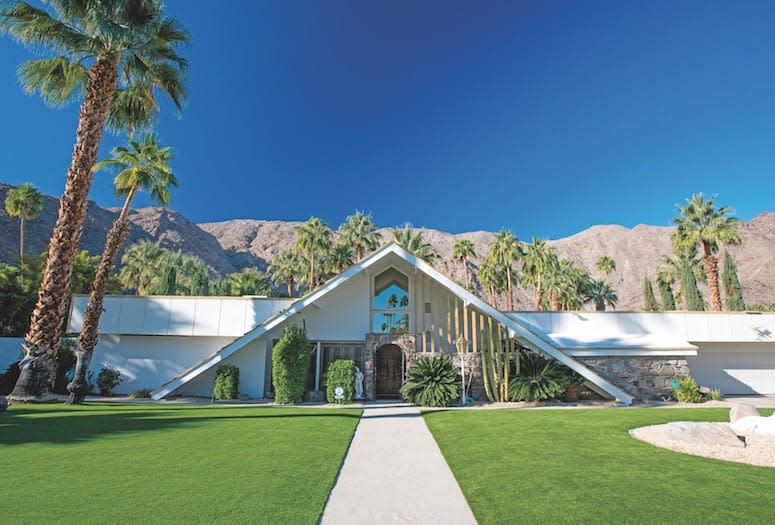
Examples
1133 Vista Vepero - 1958
1110 Abrigo Road - 1958
775 W Crescent Drive - 1958
700, 855 Via Las Palmas - 1959
1355 N Rose Ave - 1961
These homes were built in the Vista Las Palmas neighborhood of Palm Springs, which was being developed by builder Joe Dunas and the Alexander Construction Company – the local firm behind Donald Wexler's prefabricated homes. William Krisel had completed several homes in the area with his famed "butterfly" roof and flat roofs that had become typical designs in Palm Springs. But when Dunas tasked Krisel to design homes that could be distinguished from this trend, he rejected the offer. Instead, Dunas turned to architect Charles DuBois, one of modernist architecture's lesser-known figures. The pitched frames span the entire width of the residence, creating covered porch areas at the entrance and shaded terraces at the rear facing towards the pool. Inside each house, the structure forms a double-height space for the main living areas, while the rest of the facilities occupy the single-story volumes on either side. There are 15 Swiss Miss Houses remaining today in Palm Springs' Vista Las Palmas.
Sunrise L’anai - 1962 - 1964
Las Palmas Summit Historic District - 1962 - 1963
Vista Las Palmas neighborhood
Canyon Estates - 1971 - 1973
Roy Fey, Developer
In 1940, at age 25, he formed his accountancy group and then moved into residential housing development after World War II. He built at least 3,000 houses in Chicago before moving to Palm Springs in 1955 with his wife, Ethel, who had asthma. He also owned a women's wear business in Chicago, manufacturing leather and suede clothes for both men and women, as well as a trailer manufacturing plant. H also owned the American Condenser Corporation, selling those products to television set manufacturers and the U.S. government.
Upon arrival, Fey founded a real estate company, Fey’s Canyon Realtors, and a construction company, Fey Construction Company. One of his first purchases was the Desert Skies apartment hotel in Palm Springs which he paid $500,000. Located at 2290 S Palm Canyon Drive, these are now condos. He opened his office at 1011 N. Palm Canyon Dr. Immediately, he began developing residential property. He was also a founder of the Bank of Palm Springs in the early 1980s. They lived at 1120 S. Calle de Maria.
Caballeros Estates - 1959 - Designed by Wexler & Harrison
El Rancho Vista Estates - 1960 - Designed by Wexler & Harrison.
Canyon View Estates - 1962 - Designed by William Krisel
Mesquite Canyon Estates - 1979
Canyon West Estates
Albert Frey, Architect
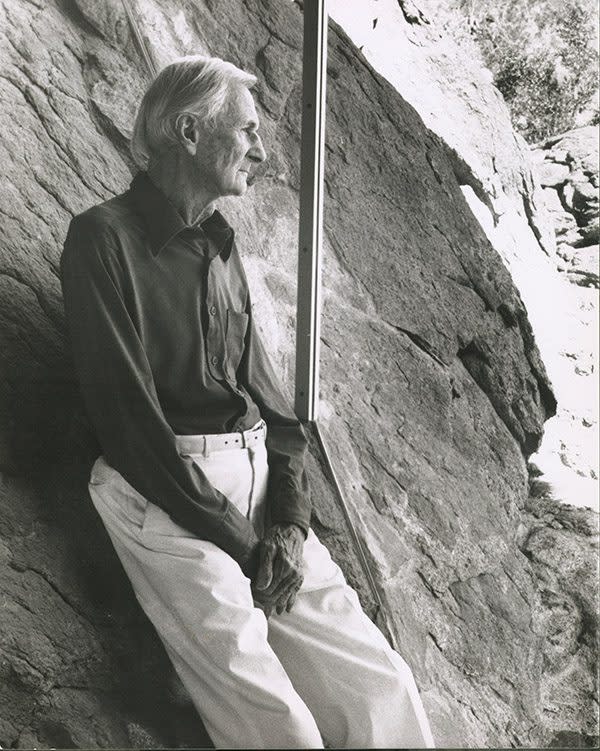
Albert Frey was born in Zurich in 1903. He was the son of Albert Frey Senior, an active artist in Zurich, Switzerland. He had three sisters who also lived in Zurich. Albert studied architecture and eventually took a position in Paris at the office of Le Corbusier under a student visa. At first, he received no salary, but eventually, he was offered a small salary because of the quality of his work. Work in Paris eventually declined, and Frey resigned. When his American visa was approved, he headed to New York, where he interviewed with A. Lawrence Kocher is also the managing editor of Architectural Record. He was offered a position for a salary of $25 a week, which was considered good money in the Depression years.
Frey and his partner, A. Lawrence Kocher, began designing the Aluminaire House in 1930. The metal and glass structure was built in less than 10 days for the 1931 Architectural League Show in New York. This full-scale house was sheathed entirely in ribbed aluminum over an insulation board covered with building paper. Aluminum posts and lightweight steel beams with non-loadbearing exterior walls supported it. Aluminum washers and screws held the house together. All window sashes, doors, and frames were steel. Built-in furniture provided efficient use of space. The expo opened on April 18th, 1931, for one week. Over 100,000 people toured. Henry Russel Hitchcock and Philip Johnson included the house in the Museum of Modern Art, “Modern Architecture; an International Exhibition” in 1932. Traveling for two years to fourteen locations in the United States, the exhibition significantly developed the American modern movement.
It was sold to architect Wallace K. Harrison, who moved it to Huntington, NY, for a guest house. After escaping demolition by a new owner in 1986, it was moved to the New York Institute of Technology. After several years, they transferred it to The Aluminaire House Foundation, which was formed in 2010 to relocate it as a museum. In April 2012, the house was again dismantled and stored in a container in Ronkonkoma, NY. In 2016, Architecture Record designated Aluminaire as one of the 125 most significant structures in the world. In 2017, it was moved to Palm Springs. It is considered among the best examples of modern architecture in the United States. It is currently erected in front of the Palm Springs Art Museum.
One of the commissions that changed his life came in the summer of 1934. It was an office/apartment dual-use building on Palm Canyon for Kocher's brother, Dr. J. J. Kocher of Palm Springs. Frey visited Palm Springs for the first time and fell in love with the desert. The building began what would be known as the “desert modernism.” After the project, there was no work for him in New York, so from 1935 to 1937, Frey stayed in Palm Springs and worked with John Porter Clark under the firm name of Van Pelt and Lind Architects, as both were yet unlicensed in California. April 1937 saw Frey briefly return to work at the Museum of Modern Art in New York. In 1939, he and his wife Marion returned to Palm Springs to resume their collaboration with Clark, which would continue for nearly twenty more years. Frey and Marion divorced in 1945, and neither remarried.
Albert Frey, Sr. arrived in the Village in September 1948 to make his home with his son, Albert Frey Jr. They lived at 1150 Paseo El Mirador in Palm Springs. He almost instantly took an active part in the work of the local art colony. Unfortunately, he passed away from pneumonia shortly after his arrival, having been ill for only a few days.
Significant buildings by Frey during this period include his private residences, Frey House I and II, the Loewy House, built for industrial designer Raymond Loewy, the Palm Springs City Hall, the Cree House II, North Shore Yacht Club on the northeastern shore of the Salton Sea, the Palm Springs Aerial Tramway Valley Station and the iconic “flying wedge” canopy of the Tramway Gas Station at the foot of the entrance to the tramway on the northern edge of Palm Springs, now used as a visitors center.
His business partner, John Porter Clark, who had much to do with the Village's development since the early 1930s, was commissioned as a First Lieutenant in the Army Engineering Corps in 1942 and stationed with the Army Air Corps at Minter Field near Bakersfield. During his absence, Albert Frey was also charged from their office at 869 North Palm Canyon Drive. During this time, Albert was also a member of the Palm Springs Desert Museum board.
Robson C. Chambers joined the firm in 1946 and was made a partner in 1952.
At the end of 1956, John Porter Clark left the firm to establish a solo practice focusing on large commercial, public, and institutional buildings. Frey remained interested in various building types, mainly residential, for which he held a particular affinity. In their non-residential work, the remaining partnership is between Frey and Chambers. When the Tramway Gas Station was completed, the firm of Frey and Chambers dissolved. From 1966 to his retirement in the 1980s, Frey worked alone. Frey’s commissions consisted primarily of additions and alterations to houses in Smoke Tree Ranch. Frey died in Palm Springs in 1998 at the age of 95 and was buried at Welwood Murray Cemetery.
Frey personified the same qualities found in his buildings: elegant, simple, streamlined, and clever. Even his wardrobe demonstrated a sensual notion of aesthetic frugality. He wore shirts, trousers, and socks in a strictly limited palette of white, powder blue, salmon, pale yellow, and beige. For Frey, Modernism was not merely a stylistic issue but a philosophical way of life.
Kocher - Sampson Building – 1934, 766 North Palm Canyon
James V. (Bud) and Mildred Guthrie House – 1935, 666 Mel Avenue
The Kellogg Studio – 1936, 321 West Vereda Sur. Altered.
The Mason House – 1937, 448 Cottonwood Road. Altered, they became condominiums.
The Chaney Apartments – 1939, 275 East Tamarisk Road
Frey House I - 1940 (demolished)
The Julian Sieroty House - 1941, 695 East Vereda Sur. Restored by Frey in 1989.
The Racquet Club Bungalows – 1945, 2743 North Indian Avenue
Villa Hermosa apartments – 1946, 155 Hermosa Place
The Colgan Apartments – 1946, 269 Chuckwalla Road. The name changed to Villa Orleans.
The Raymond Loewy House – 1946, 600 West Panorama Road. Minor alterations.
The Andrew and Anna Jergens House, aka Graceland West – 1946, 845 West Chino Canyon.
Bel Vista Residence – 1946, 1164 North Calle Rolph. Designed by John Porter Clark.
Sun View Estates Home - 1950
Palm Springs City Hall - 1952 – 1957, 3200 E Tahquitz Canyon Way
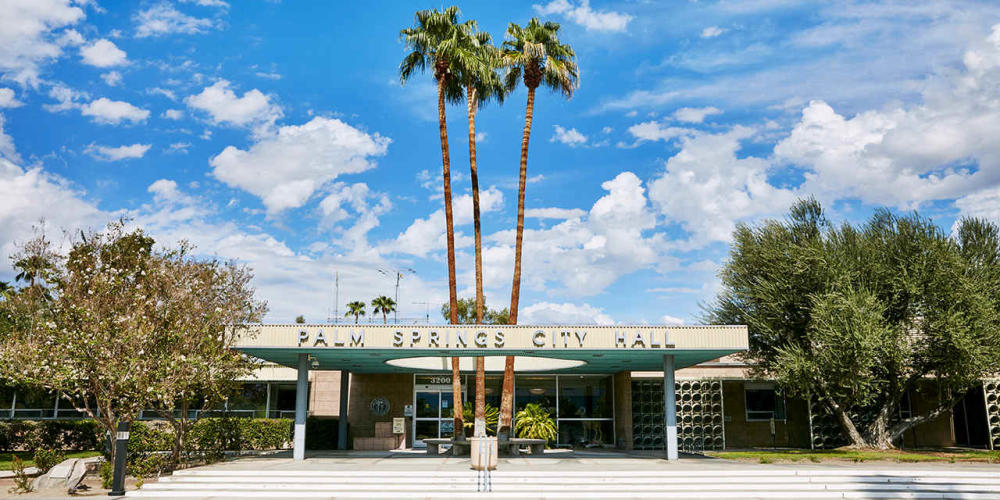
The Laura Carey House, aka the Carey-Pirozzi House – 1956, 651 West Via Escuela
The Frelinghuysen House – 1959, 707 Panorama Road. There were alterations, then a restoration after 2000.
The Monkey Tree Hotel – 1960, 2388 E Racquet Club Rd
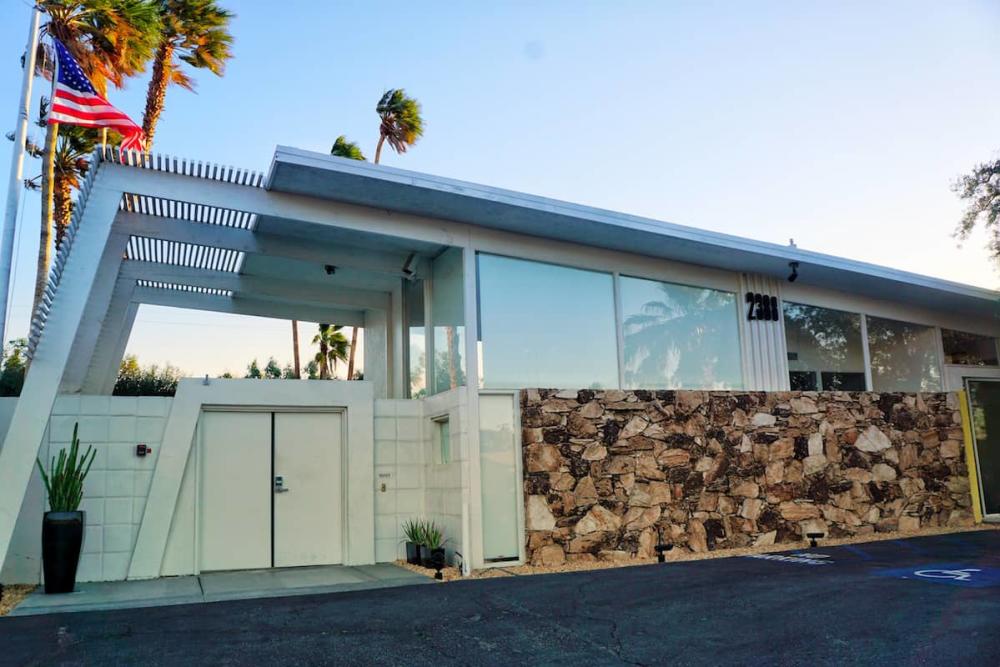
Palm Springs Aerial Tramway Valley Station - 1963
The Hugo Steinmeyer House – 1962, 318 Pablo Drive
Residence – 1964, 318 West Pablo Dr
Frey House II – 1964, 686 Palisades Drive
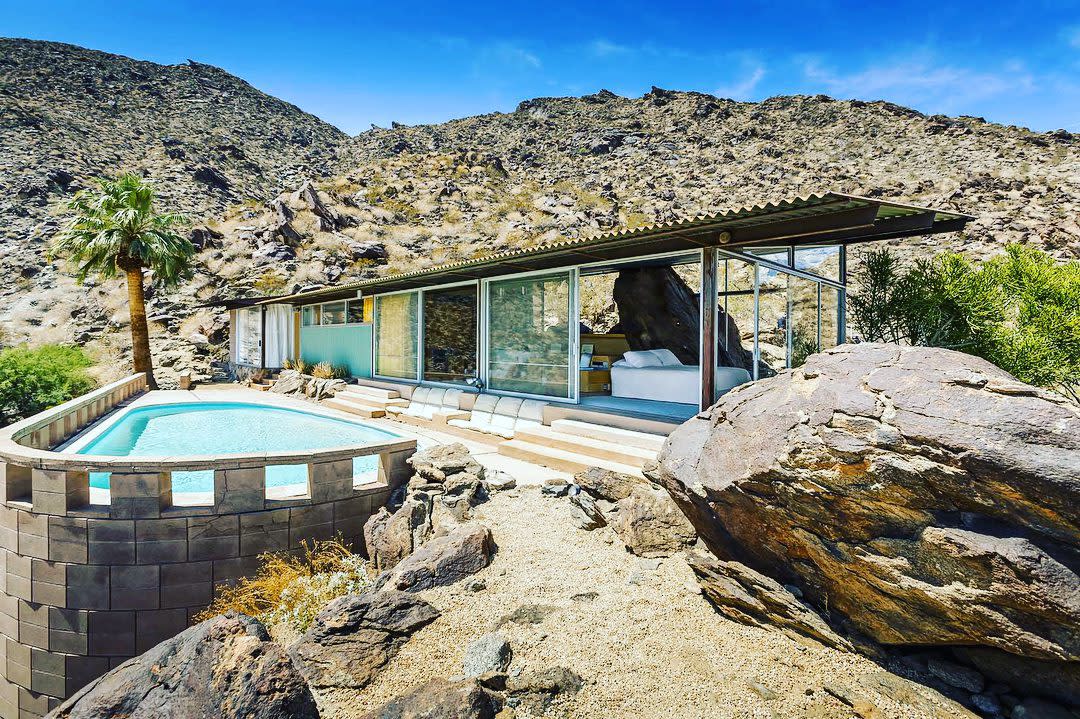
Frey House II
Tramway Gas Station, aka the Palm Springs Visitor Center- 1965, 2901 N Palm Canyon Drive
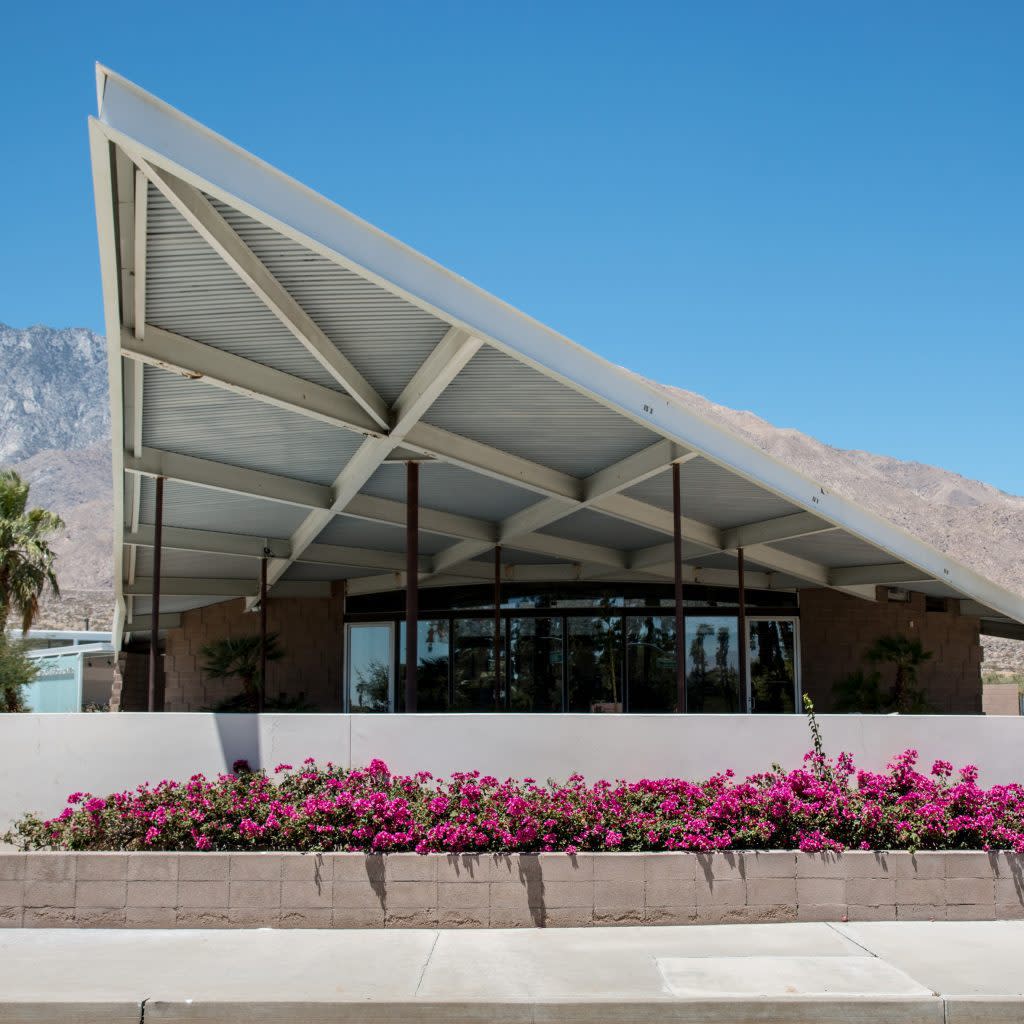
Alvah Hicks, Developer
Alvah Hicks was born in Pennsylvania and moved to Palm Springs in 1912. A master carpenter by trade, Hicks built many of The Desert Inn buildings and oil magnate Tom O’Donnell’s house above what is now the O’Donnell Golf Course. O’Donnell financed Hicks’ purchase of the Whitewater Mutual Water Company from Prescott T. Stevens in the 1920s, and Hicks founded Palm Springs Water Company, as well as the first building supply store in the area, located at present-day Sunny Dunes Road and Palm Canyon Drive. Hicks also built the Ingleside Inn and several houses in the 1920s and 1930s. Many of Hicks’ buildings were designed by William Charles Tanner, an “architectural artist.” In the 1940s, Hicks developed the Little Tuscany Estates. He served on Palm Springs’ first city council and was involved in the City’s incorporation in 1938.
A. Quincy Jones, Architect
A. Quincy Jones was an architect from Los Angeles who designed many glamorous mid-century modern homes. He owned his firm, A. Quincy Jones, AIA, and Associates. The company won the coveted American Institute of Architects Architectural Firm Award for "overall achievement in architecture" in 1969, and Jones personally received more than 70 citations for excellence in his field. He collaborated with many architects, including Paul R. Williams, for a few Palm Springs projects.
Tennis Club Addition - 1946
Town & Country – 1947, 169 N. Indian Canyon
Bank of America – 1949, 146-150 North Palm Canyon Drive
The Jerome J. Robinson House – 1957, 999 North Patencio Road
Country Club Estates Condo – 1965, La Vern Way, South Camino Real
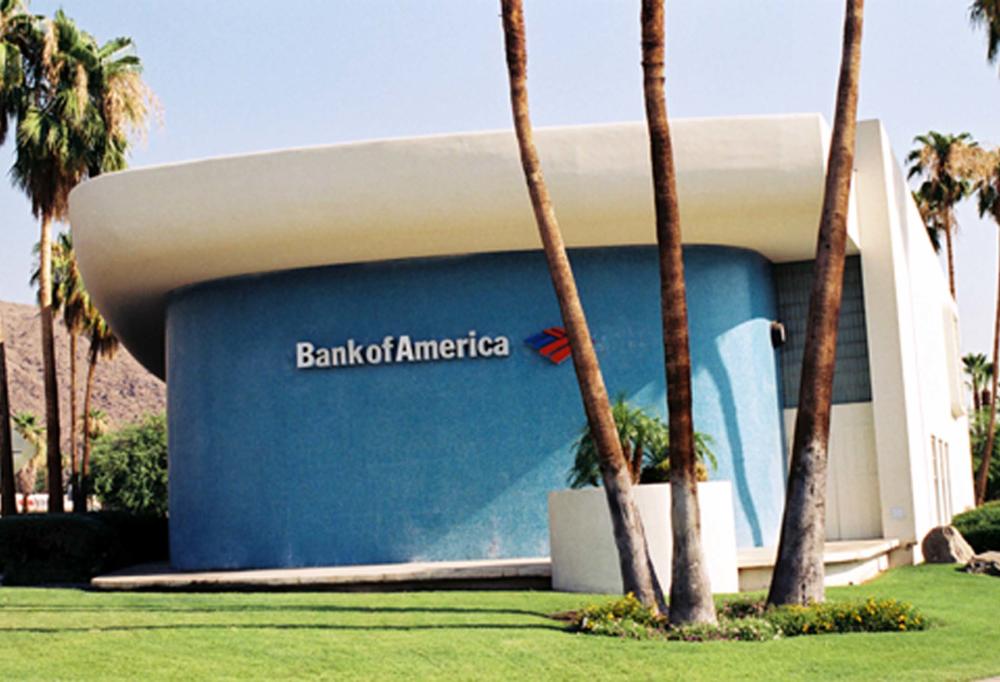
Hugh Kaptur, Architect
Hugh Kaptur arrived in Palm Springs in 1954. Kaptur first worked briefly for Wexler & Harrison but was laid off during the 1957 recession. Skilled at free-hand drawing, he made artist’s renderings of buildings for Wexler, Albert Frey, and other local architects. Business picked up in 1958 when homebuilders began developing Palm Springs on a large scale, and Kaptur found himself designing post-and-beam houses. In 1962, he formed a partnership with licensed architect Robert Ricciardi to get the commission for Palm Springs Fire Station #3 and the Palm Springs Golf Course Clubhouse. After that partnership broke up in 1965, he formed a company with Larry Lapham, noted architect Howard Lapham's son, which lasted ten years. After a partnership with James Cioffi, he semi-retired in 1992. In 2001, Hugh Kaptur's life took a new turn when he married Helen Dzo Dzo. Helen, a professional model in the 1960s, was a favorite of designers and photographers. Her friendship with Nelda Linsk led to a memorable event in 1970. Helen was invited to the Kaufmann house for a photo shoot by Slim Aaron, immortalizing the iconic photo 'Poolside Gossip,' which came to symbolize the epitome of the Palm Springs lifestyle.
Noel Gillette House – 1957, 1033 East Via Colusa
Impala Lodge – 1958, 555 East San Lorenzo Road
Arthur and June Boyer House – 1958, 984 North Rose Avenue
The Hugh and Rosemary Kaptur House – 1958, 1897 East Belding Drive
Desert Park Estates - 1958 Earl Stroube Spec House I – 1958, 1951 South Camino Monte
Earl Stroube Spec House II – 1959,1935 South Camino Monte
The Pete Siva House – 1959, 660 Palisades Drive
Residence - 1960, 1577 Calle Marcus
Palm Springs Fire Station #3 – 1963, Corner Via Miraleste and Racquet Club (next to Victoria Park)
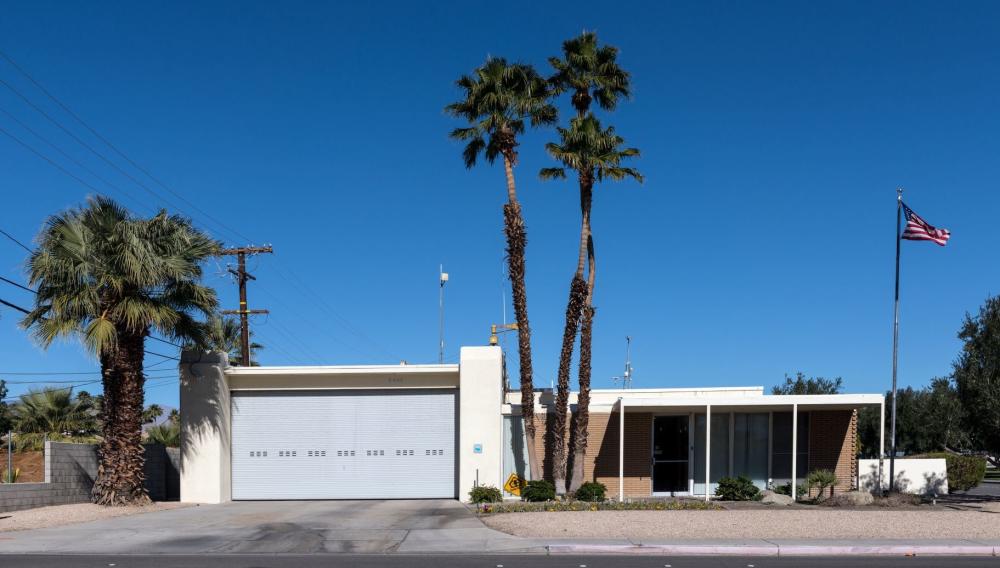
Steve McQueen House – 1964, 2203 Southridge Drive
Casa Blanca Motor Hotel, now Musicland Hotel – 1967, 1342 South Palm Canyon Drive
Tahquitz Creek Golf Course Clubhouse – 1967, 1885 Golf Club Dr
Palm Springs Fire Station #4 – 1971, 1300 S La Verne Way
Desert Dorado - 1973
The William Holden House – 1977, 2433 Southridge Drive
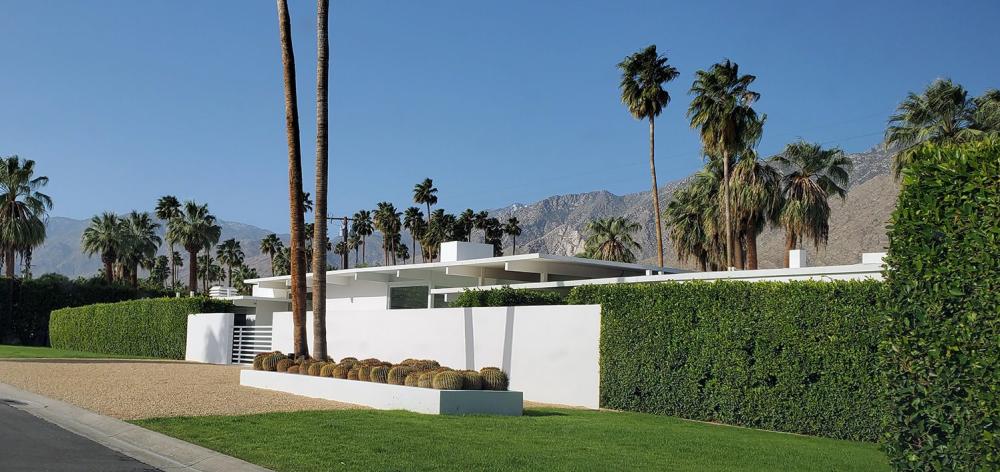
Canyon West Estates Condominiums - 1978
Canyon East Estates Condominiums - 1978
Palm Villas – 1979, 3155 Ramon Road
Tahquitz Plaza - 1974 – 1977, 600 - 700 East Tahquitz Canyon Way
Rancho El Mirador Condominiums – 1983, 291 E Mel Avenue
The Deauville Condominiums – 1985, East Amado Road and El Segundo
Villa Caballeros Condos – 1985, 255 S Avenida
Caballeros Villa Serena Apartments - 1986, 900 East Saturnino Road
Pueblos Apartments - 1987
Paul and Kay Selzer House – 1988, 38727 Maracaibo Circle
The Villas – 2002, 1700 South Araby Drive
Kaptur Court – 2016, 262 West Vista Chino
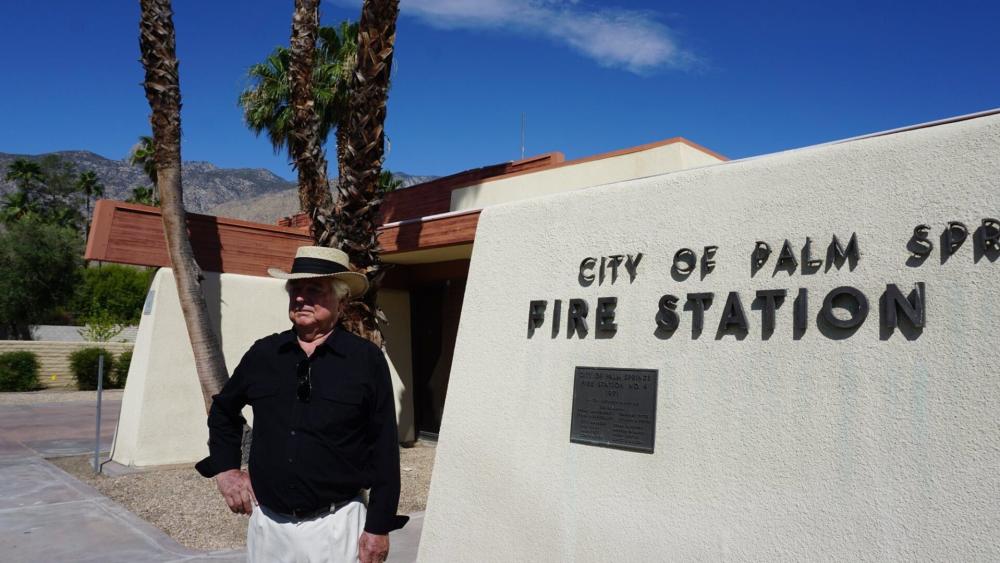
William Krisel, Architect
William Krisel, AIA, principal of the firm of Palmer & Krisel (formed with Partner Dan Palmer), was born in 1924 in Shanghai to American parents working overseas for the U.S. State Department. Krisel lived in China until age 13, when his family returned to the US, where he attended Beverly Hills High. He entered the army in the intelligence department and served as the Chinese-language interpreter for General Stillwell. On a GI Bill, he received his degree in architecture at USC in 1950 and has been a licensed landscape architect since 1954.
Krisel went into partnership with Dan Saxon Palmer. Palmer and Krisel, A.I.A. Architects, designed custom homes and commercial projects tract homes in the Los Angeles area. As early as 1952, Palmer & Krisel’s modular post and beam construction system proved popular and effective.
A close personal friend of developer Bob Alexander and his family, Krisel came to the Desert at Alexander's request to design a tract of modernist houses dubbed Smoke Tree Valley (now known as Twin Palms for the pair of Palm trees that graced each of the homes).
Other Palmer & Krisel projects include the Ocotillo Lodge, Las Palmas Estates (Vista Las Palmas), Kings Point and Canyon View Estates, Racquet Club Estates, “Valley of the Sun” in Rancho Mirage and the Sandpiper condo complex in Palm Desert (which garnered an AIA merit award for Landscape Architecture). The “House of Tomorrow,” conceived as an experiment in modern living, impressed Alexander's wife Helene so that they made it their residence. The house later gained fame as the honeymoon home of Elvis and Priscilla Presley.
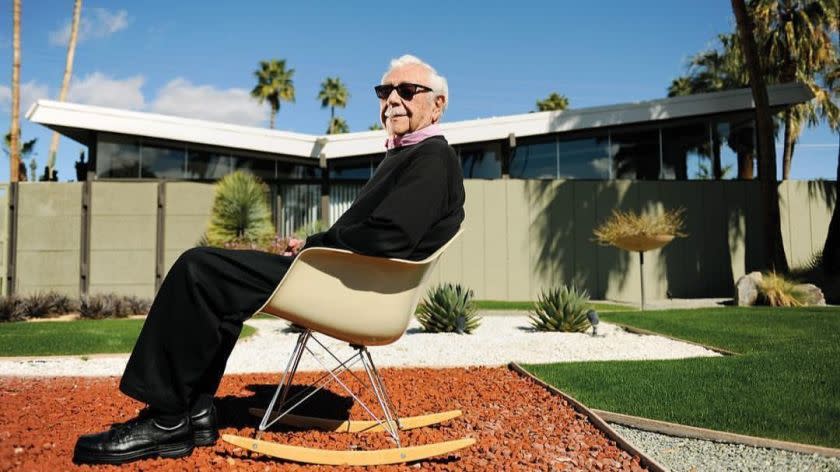
Architect William Krisel at one of his Twin Palm homes.
John Lautner, Architect
Lautner studied under Frank Lloyd Wright at Taliesin West and became site supervisor on several Wright projects, including Ennis House, Los Angeles. An iconic image like a cave, terrace, or unique roof line or shape often characterizes his projects. He would do models of the designs because he felt drawings were not always easy to visualize the space. In 1938, Lautner moved to Los Angeles and created a lifelong career focusing on residential architecture. Two of his most recognized works are Elrod House and Bob Hope’s Flying Saucer House.
Elrod House - 1968
Bob Hope Residence - 1973 - 1979
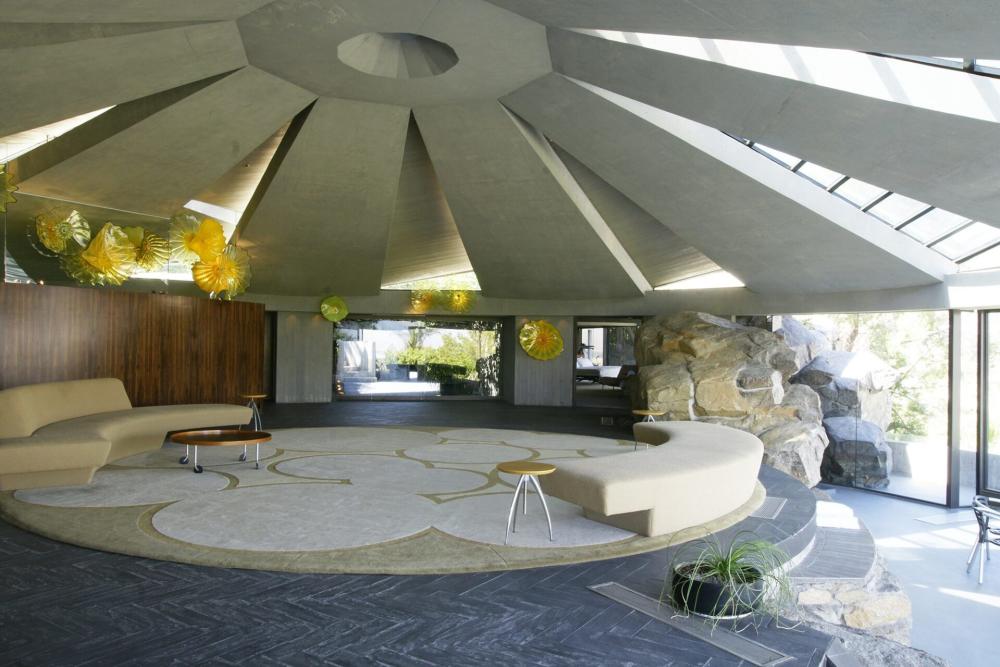
Jack Meiselman, Developer
Jack I. Meiselman was born in New York City to Jewish parents and was one of six children. During the 1920s, Meiselman relocated to Chicago and worked in the family handkerchief manufacturing business, but he also broadened his interests in construction. He did well financially there and married his wife, Berne “Babe” Meiselman. They were always both listed as co-owners/sub-dividers of Meiselman tracts. In 1944, the Meiselman’s moved to California. They appeared in the Palm Springs City Directory in 1946 at 1276 Indian Avenue. By 1948, the Meiselman’s had moved to 1240 Monte Vista Avenue. He was a developer, not an architect, but his firm developed the designs.
In the 1950s, Meiselman developed hundreds of mid-century modern-style tract homes in the city. Meiselman was fond of making functional and decorative exterior walls out of meticulously-designed concrete bricks. Such walls are beautiful, allow breezes to pass through, and provide shade. Common elements of Meiselman homes are their tongue-and-groove ceilings, clerestory windows, scored stucco, concrete block, and walls of glass at the rear. The homes were also all installed with central heating and air conditioning, a scarce commodity in 1959. He worked with George Gannon, president of Gannon Realty, which had been in Palm Springs since 1934.
El Mirador Park - 1946 -1955, 1252 Pasatiempo Road.
Luring Sands Park - 1953
Karlisa Cove - 1956
Palm Lane Estates - 1956 - 1958
Ramon Rise Estates – 1956, corner of El Cielo and Ramon Road.
Chino Palms Estates - 1958 - 1959
Alejo Palms Estates - 1959
Richard Neutra, Architect
Richard Neutra built the Grace Lewis Miller House in 1937 at 2311 N. Indian Canyon Drive. Although a small home, it combined a dance studio for the owner. It is a good representation of Neutra’s use of simple, flat-roofed forms arranged and adapted to the sun, outdoor space, and the need for coolness and ventilation in the desert. The glass and steel home comprises taut plane surfaces with no ornamentation. Neutra created a modern Southern California regionalism, combining a light metal frame with a stucco finish to create a light, effortless appearance. “He specialized in extending architectural space into a carefully arranged landscape. The dramatic images of flat-surfaced, industrialized residential buildings contrasted against nature.
In 1946, Edgar Kaufmann hired Neutra to design a desert home for his family in Palm Springs. A decade earlier, Frank Lloyd Wright had built Fallingwater for Mr. Kaufmann. But Kaufmann, having seen Taliesin West, thought that Wright didn’t understand desert design and chose Neutra instead. The home turned out so well that when Wright saw it, he admitted it was beautiful (uncharacteristic of him). The building remains the most famous in Palm Springs in terms of international recognition.
It is located at 470 West Vista Chino Road. The flat roof, steel frame, and glass walls embodied one prominent version of Modernism by using sharp, clean, minimalist, machine-made lines, contrasting with the beauty of the open, natural site with the rugged slopes of Mt. San Jacinto as a backdrop. Using stone and wood finishes represented an evolution of Neutra's ideas from those seen in the earlier Miller House (1937, 2311 N. Indian Canyon Drive; HSPB-45). To finish the home, Kaufmann employed three crews, working 24 hours a day. He had a personal representative on the site, constantly on the phone with him, and drove up costs significantly with 600 change orders. A house initially priced at $35,000 — a pretty penny in the lean years immediately following World War II — ballooned to $295,000.
When Julius Shulman photographed it and disseminated it worldwide, the Kaufmann House became an iconic image of Modern architecture. The north wing is the guest’s quarters, which are publicly accessible but retain their private needs as they are separated from the rest of the house. The house's west wing is the service wing, which is pretty secluded from the rest of the open-plan design. The east wing is the most privatized aspect of the house, as it is Kaufmann’s primary suite.
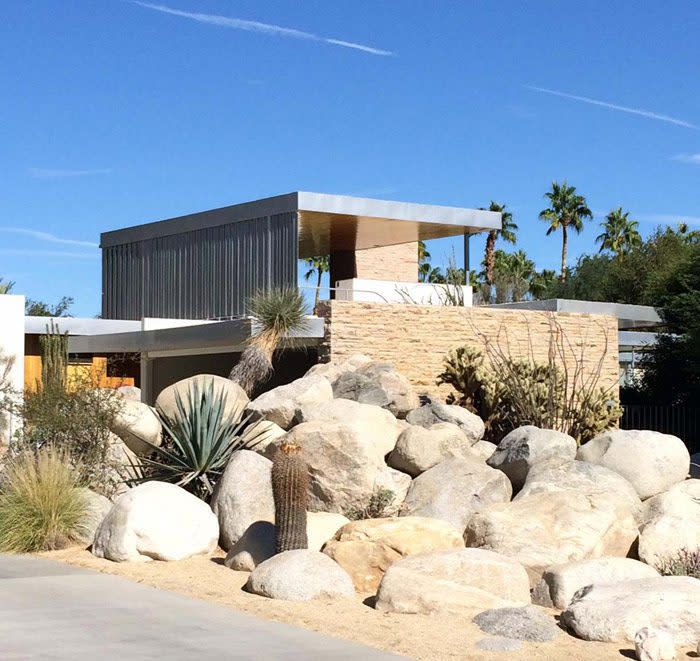
Dan Palmer, Architect
By 1955, Palmer was overseeing work in Orange and Ventura counties, and Krisel in San Diego and Riverside counties. By the end of the 1950s, George Alexander, Harlan Lee, and other developers had built more than 20,000 houses designed by Palmer and Krisel in Southern California, Arizona, Nevada, Texas, and Florida. Palmer and Krisel collaborated on projects in the Los Angeles area until their partnership was dissolved in 1964.
James Schuler Associates
Villa Roma - 1963
Paul Trousdale, Developer
On either side of the banks of Tahquitz "Wash," just south of central Palm Springs, lies this neighborhood, which uniquely represents the past, the present, and the future of Palm Springs. Paul Trousdale partnered with Pearl McManus to build 200+ modern and traditional-style homes in the Tahquitz River Estates neighborhood.
Not much could be done with it at first because the "river" would carve a new direction each rainy season. The first development in the area was called Palos Verdes Estates, which was built in the early 1930s on land originally owned by Judge John McCallum. When the county finally stabilized the banks, "Auntie" Pearl teamed with a famous builder from Los Angeles, Trousdale, to develop homes on either side of the banks.
Donald Wexler, Architect
Donald Wexler moved to Los Angeles in 1950, where he worked for architect Richard Neutra. He subsequently moved to Palm Springs to work for William Cody at the Tamarisk Country Club. In 1952, Wexler, along with Richard Harrison, a colleague from Cody’s firm, set up their own offices as Wexler & Harrison. That partnership dissolved amicably in 1961, and Wexler formed Donald A. Wexler Associates in 1963. Wexler retired in 2002. He was named a fellow of the American Institute of Architects in 2004. In 2009, he was the subject of a documentary titled Journeyman Architect: The Life and Work of Donald Wexler. Wexler passed away in Palm Desert on June 25, 2015, at the age of 89.
Joe and Joyce Pawling House – 1954, 230 West Lilliana Drive
Leeds-Howard House I – 1954, 515 Via Lola
Wexler Residence – 1955, 1272 East Verbena Drive. Wexler made additions in 1965 and 2007.
Ted Leff House – 1957, 362 West Via Sol
Leeds-Howard House II – 1959, 375 Via Lola
Zen House – 1959, 1344 South Calle de Maria
El Rancho Vista Estates - 1959 - 1960
Spa Resort Hotel – 1959 (demolished)
Roy Fey Spec House – 1960, 615 Avenida Caballeros, 755 Avenida Caballeros, 681 Avenida Caballeros, 620 North Camino Real
Tony Curtis and Janet Leigh House – 1960, 641 North Camino Real. This was also a Roy Fey spec house.
Prefabricated Steel Houses - 1962
1 - 290 East Simms Road
2 - 3125 Sunny View Drive - Recognized by the National Register of Historic Places in 2012.
3 - 3100 Sunny View Drive - Purchased in 1993 by Jim Moore, long time GQ creative director. He restored it well enough that it has been shot for several magazines and used as a location in fashion ad campaigns.
4 - 3133 Sunny View Drive
5 - 3165 Sunny View Drive
6 - 300 Molino Road 7 - 330 Molino Road
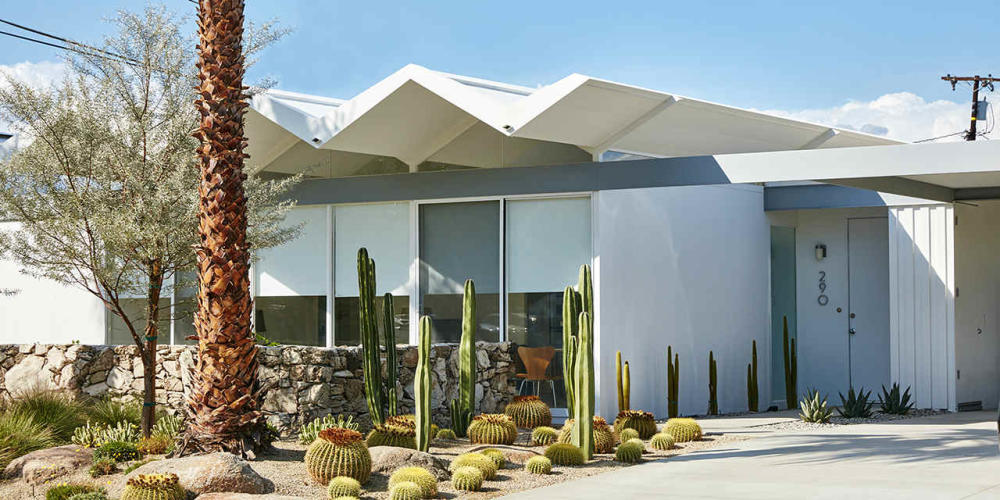
Canyon Country Golf Club - Clubhouse - 1963
Dinah Shore Estate – 1964, 432 West Hermosa Place
Green Fairway Estates - 1964
Palm Springs Airport Terminal – 1965, 3400 East Tahquitz Canyon Way
Raymond Cree Junior High School – 1966, 1011 E Vista Chino, Palm Springs, CA 92262
Michael and Barbara Heathman House – 1969, 633 South La Mirada Drive. Renovated by Wexler in 1987. Merrill-Lynch building – 1970, 415 S Palm Canyon Drive
Sagewood Condominiums - 1972 Twin Springs Condominiums – 1973, South Sierra Madre
Palm Springs Pavillion - 1974
The Rose Garden - 1978 Cecil P. Jones House – 1982, 899 Tamarisk Road
Allen Miller/Tropicana Townhomes – 2003, Prescott Drive
Stewart Williams, Architect
E. Stewart Williams arrived in Palm Springs in 1946 to join his father, Harry, and brother, Roger Williams, in architectural practice. Stewart’s father decided to move to Palm Springs in an attempt to ease the distress of his wife, Una, who had severe rheumatoid arthritis. Palm Springs was not new to Harry Williams, as he had designed the Spanish Colonial Revival style La Plaza Shopping Center for Mrs. Julia Carnell, an important Ohio-based client, in the heart of the growing desert city in 1936. After settling in Palm Springs following America’s entry into World War II, Harry Williams opened an architectural firm, obtaining commissions almost immediately. During World War II, the firm of Harry J. Williams was responsible for numerous single and multi-family dwellings, several medical clinics, a local hospital, a handful of retail stores, a hotel, high school classrooms, restaurants, a Masonic Temple, and a service station, among other projects.
Stewart moved to Palm Springs with his wife and two children at the age of 38. While studying in Stockholm, Stewart met and married Mari Schlytern, cousin of Anders Beckman, designer of Sweden’s exhibit at the New York World’s Fair. Mari and her two children, Jan Erik and Mari Anne, stayed at La Plaza, where the Williams maintained their architectural offices.
He was a graduate of Cornell and Pennsylvania universities. He came to California from the east after four years on the faculty of Bard College, Columbia University, where he taught both architectural design and modern painting. He was also associated with the firm of Raymond Loewy, a nationally known industrial designer, for several years in New York City. At 35, he has already won numerous prizes and medals for outstanding work in the arts, among them the American Institute of Architects Student Medal, the American Water Color Society's Zabduskie Prize, and the American Academy in Rome Collaborative Prize.
Almost immediately, he took on the lead designer role in constructing two modest commercial buildings and his first important residential commission, the residence of Frank Sinatra. In the ensuing five decades of his career, Williams successfully united the warmth of natural materials with the precision of International Style Modernism in designing buildings devoted to client needs while tailored to the local setting. The business name was Harry J. Williams until 1948, when it became the firm of Williams, Williams, and Williams. Williams’ architectural impact in the Coachella Valley was enormous. It is revealed in the number of projects he has built: houses, schools, hotels, banks, religious buildings, and educational and cultural institutions. It is revealed in the prominence of some of his buildings:
The Frank Sinatra House – 1947, 1148 East Alejo Road
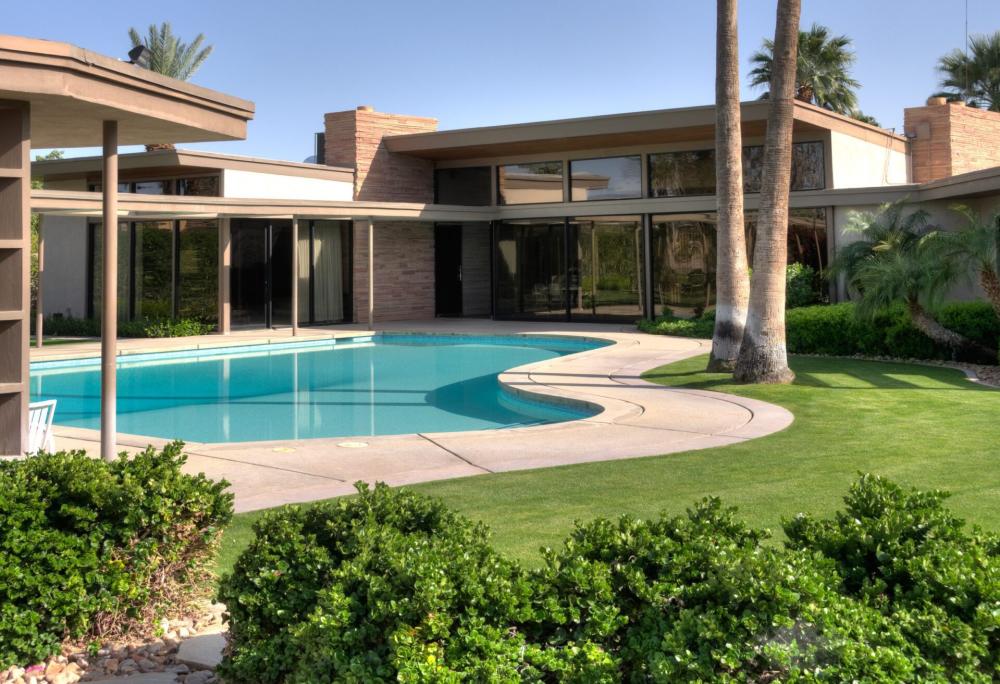
Palm Springs High School, 333 South Farrell Drive
Temple Isaiah, 1949-1951 (substantially altered)
Oasis Commercial Building, 1953 - 1955, southwest corner of Palm Canyon Drive and Tahquitz
The Edris Residence – 1954, 1030 West Cielo Drive
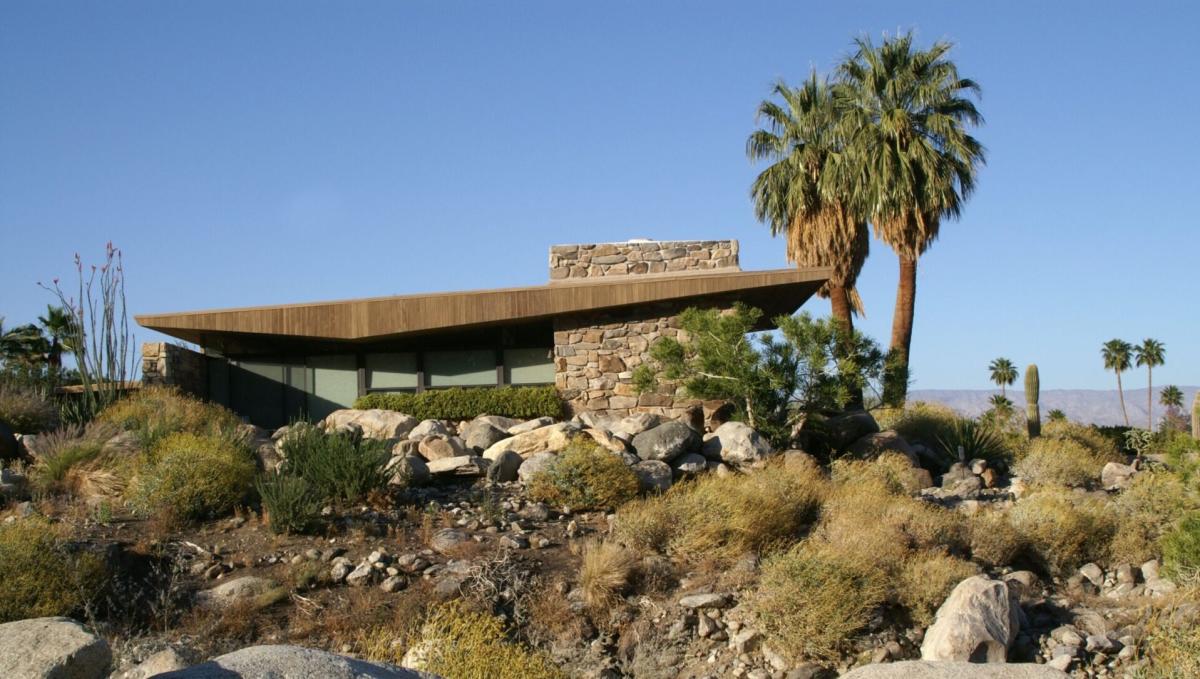 Koerner Residence - 1955, 1275 West Calle de Maria
Koerner Residence - 1955, 1275 West Calle de Maria
Harold Hicks Real Estate and Insurance Building – 1955, 345 North Palm Canyon Drive
E. Stewart and Mari Williams Residence - 1955, 1314 Culver Place
Koerner Residence – 1955, 1275 South Calle de Maria
Coachella Valley Savings #1 – 1956, 383 South Palm Canyon Drive
Santa Fe Federal Savings and Loan Association, 1960, 300 South Palm Canyon Drive
Coachella Valley Savings #2 - 1961, 499 South Palm Canyon Drive
Sutter House – 1960, 1207 Calle de Maria
The Palm Springs Art Museum - 1976
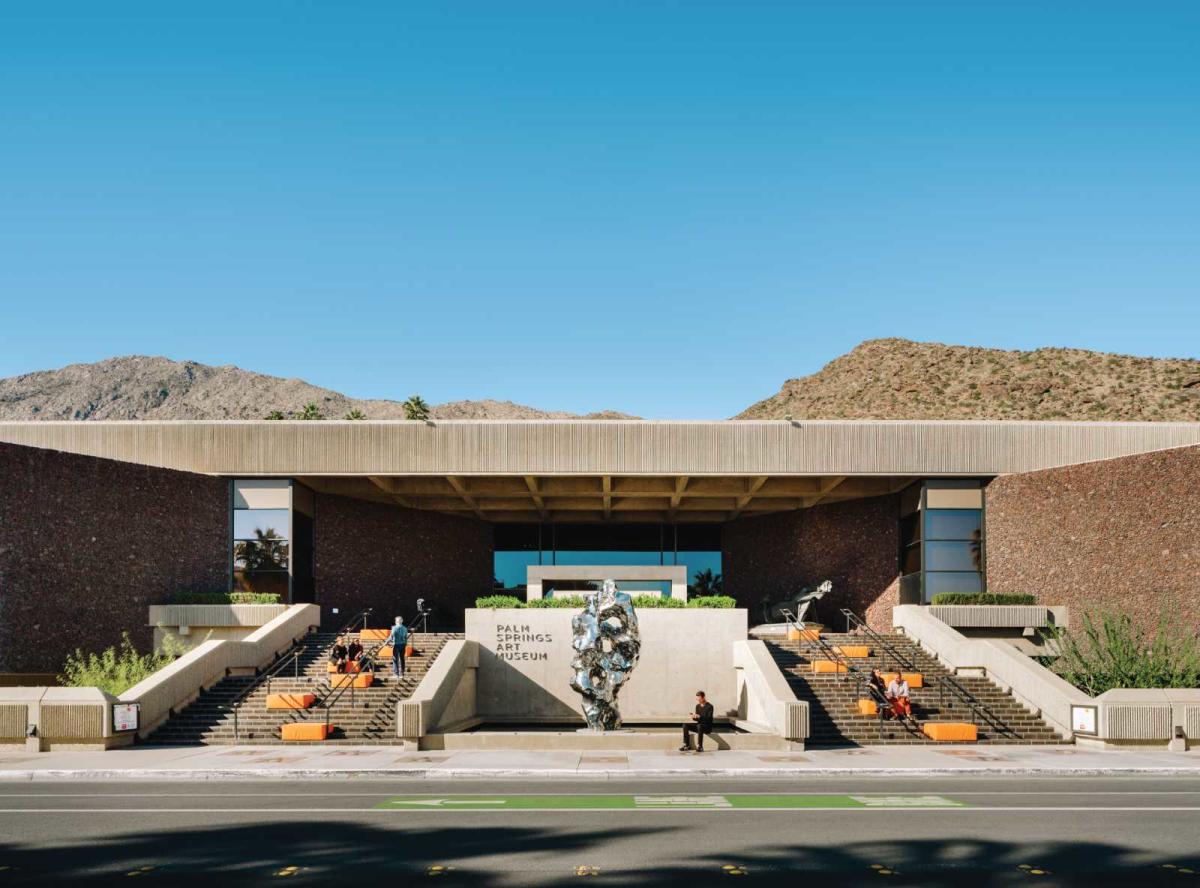 Erik and Sidney Williams House – 1986, 800 West Stevens Road (son and daughter-in-law)
Erik and Sidney Williams House – 1986, 800 West Stevens Road (son and daughter-in-law)
Sutter House, 1207 South Calle de Mariafrey
Mid-Century Architecture Self-Guided Tour
Palm Springs Architecture
Mod Squad Tours
Palm Springs Self-Guided Colored Door Tour
- 8 min read
The colored doors of Palm Springs are delightful and popular. This…
Discover Palm Springs Through the Eyes of Architectural Historian Michael Stern
- 5 min read
Conventionally, buildings are constructed to shield us from the…
Mod Squad Tours: Experience Palm Springs Architecture Up Close
- 4 min read
Palm Springs is a living museum of midcentury modern architecture, and…
Complete Guide to Modernism Week 2025
- 29 min read
Thank you for joining us for Modernism Week. We look forward to seeing…
9 Midcentury Boutique Resorts: Where Timeless Design Meets Desert Luxury
- 8 min read
9 Iconic Midcentury Modern Resorts & Inns Palm Springs isn’t…
